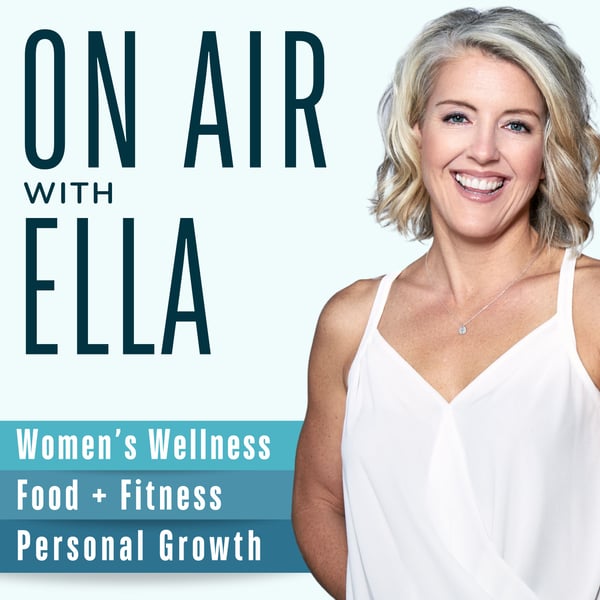⚡️MINI-SODE: 3 Things that are KILLING your Nitric Oxide production to Reduce Sexual + Athletic Performance
ON AIR WITH ELLA | Women's Wellness
Ella Lucas-Averett
5 • 704 Ratings
🗓️ 4 October 2024
⏱️ 10 minutes
🧾️ Download transcript
Summary
A BITE-SIZED BOOST TO YOUR DAY!
In this mini:
- The surprising ways we disrupt Nitric Oxide production
- Erectile dysfunction (in women and men) and the role of Nitric Oxide
- The dire consequences of mouthwash, antacids and fluoride on your Nitric Oxide production
🌟 Guest: Dr. Nathan Bryan
🎧 Get the FULL episode (#305) in APPLE or SPOTIFY
📝 Show notes: www.onairella.com/post/305-nitric-oxide
🎧 Related episodes:
--------------------------------
On Air With Ella is for women who want to feel better, look better, live better - and have more fun doing it. This is where we share simple strategies and tips for living a bit better every day. If you’re interested in mindset and wellness, healthy habits and relationships, or hormone health, aging well and eating well, then you’re in the right place.
Connect with Ella:
☎️ Leave a voice message: +1 (202) 681-0388
🎧 Free Custom Playlist - grab yours here.
-----------------------------------
🚨 Join us May 9th for the Women of Impact event in NJ! Time is running out to SAVE YOUR SEAT!
💟 Treat Ella to a Coffee? For the cost of a cup of ☕️ you can help us grow - thank you! Make your donation here.
🛍️ DISCOUNTS & PROMOS - shop, save and support!
- Build and keep muscle. Shop Kion Amino Acids - save with promo code ONAIRELLA
- My favorite probiotic Oxyceutics - use code ELLA15 to save 15% (use “subscribe & save” for additional 20% discount)
>>> See all of my discounts and brands that I love right...
Transcript
Click on a timestamp to play from that location
| 0:00.0 | Welcome to this on-air with Ella minisode, a little bite-sized boost to your day, always quick, |
| 0:05.8 | always thought-provoking, and always under 10 minutes. Let's go. And then does nitrous oxide, |
| 0:14.1 | does our natural production decline as we age? Do I have that right? That's correct. On average, |
| 0:19.5 | if you look at like population-based studies, |
| 0:21.6 | we lose about 10 to 12 percent of our nitric oxide production. We lose about 10 percent of that function |
| 0:26.6 | per decade. So by the time we're 40 or 50, we only have about 50 percent of the nitric oxide |
| 0:30.9 | we had in the way. But that doesn't have to be the case. We can actually prevent this age-related decline. We know how to recouple the Moss enzyme, |
| 0:38.3 | maintain its normal function. But if you look at population-based studies, the trend is very clear. |
| 0:43.8 | The older we get, the less we make. Okay, I want to talk specifically about what types of foods help, |
| 0:48.8 | but let's not get there yet. I'm going to stay in science class for just another moment. |
| 0:52.6 | Let's say I'm your average 44-year-old. I'm not |
| 0:56.5 | super athletic. I'm just kind of living my life. What are some ways I might observe a decline in |
| 1:02.3 | nitric oxide, whether I'm male or female? Sure. Well, first thing that happens is you're going to |
| 1:06.8 | develop some type of sexual dysfunction, and it's both erectile dysfunction in men and women. So if you think about this, when we're stimulated, that tells our sex organs to make |
| 1:15.8 | nitric oxide, which dilates the blood vessels, and then increases blood flow, and that's engorging. |
| 1:21.1 | It's clitoral engorgingment or it's penile engorging. And that's responsible for normal sexual function. |
| 1:25.4 | So if you can't make nitric oxide, then you don't get |
| 1:28.4 | dilation of the blood vessels of the sex organs and you develop erectile dysfunction. It occurs in both |
| 1:32.8 | men and women. That's typically the first sign and symptom. In fact, we call that the canary in the |
| 1:36.5 | coma. Secondly, you get an elevation in blood pressure. Nitric oxide is a vasodilator, so it keeps the |
| 1:42.3 | blood vessels soft and compliant and your blood pressure |
| 1:44.9 | normal. If you lose the ability to make nitric oxide, your blood vessels don't dilate and |
... |
Please login to see the full transcript.
Disclaimer: The podcast and artwork embedded on this page are from Ella Lucas-Averett, and are the property of its owner and not affiliated with or endorsed by Tapesearch.
Generated transcripts are the property of Ella Lucas-Averett and are distributed freely under the Fair Use doctrine. Transcripts generated by Tapesearch are not guaranteed to be accurate.
Copyright © Tapesearch 2025.

